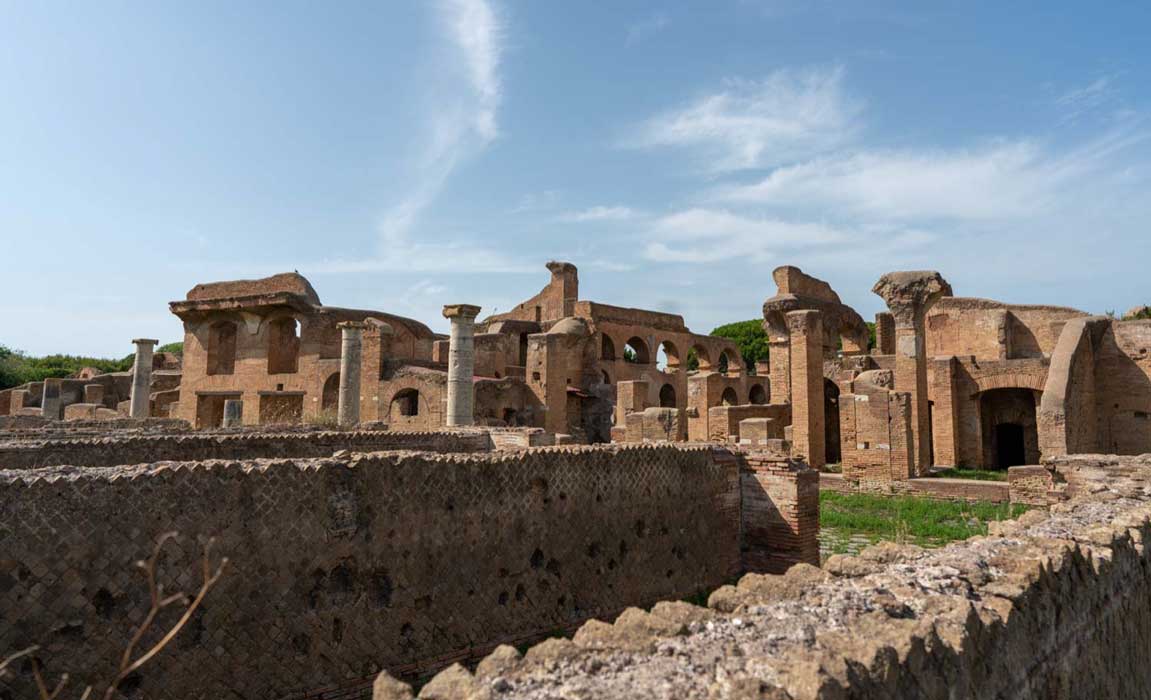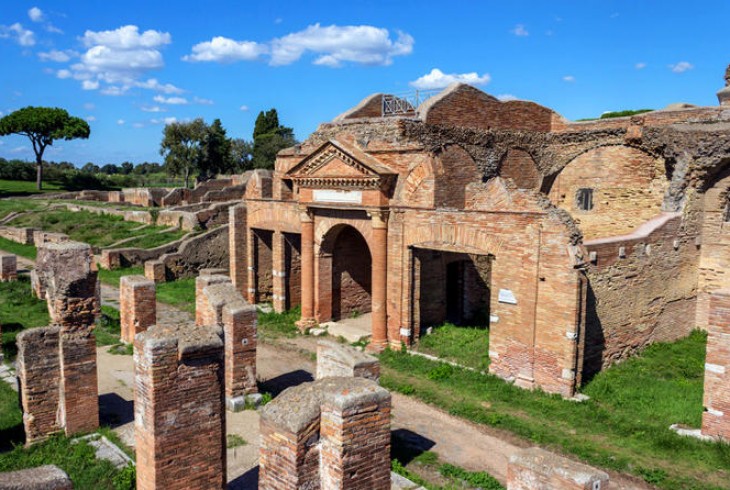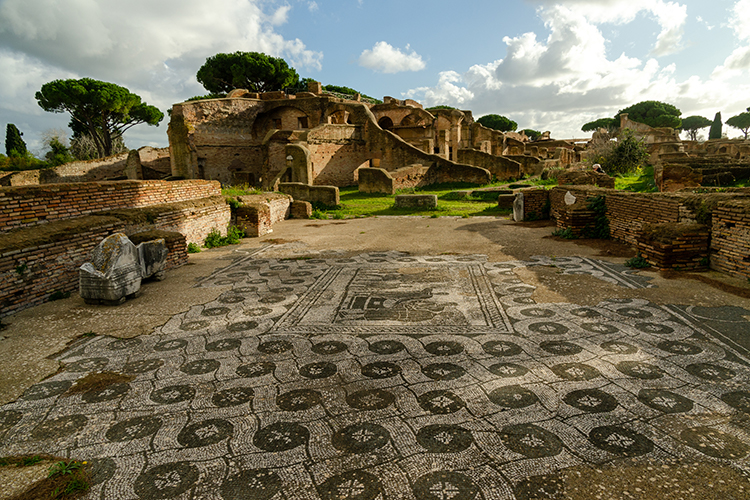Ostia Antica is an archaeological site located on the outskirts of Rome. Although the Romans referred to the site as Ostia, this article will use the term Ostia Antica, so as to avoid confusion with the modern Roman municipio of Ostia (known officially as Lido di Ostia). Ostia Antica was the harbor city of ancient Rome and was therefore an important commercial center.
The city enjoyed great prosperity during the Imperial period, but began to decline around the 3rd century AD. This decline was gradual, and Ostia Antica was finally abandoned during the 9th century AD. During the Medieval and Renaissance periods, the ruins of the ancient Roman city were quarried for building materials and sculptor’s marble respectively. Nevertheless, for the most part, Ostia Antica was largely left undisturbed.
During the 19th century, the first archaeological excavations were carried out under papal authority. Under the regime of Benito Mussolini, excavations at Ostia Antica intensified, until about two thirds of the site were unearthed. Today, Ostia Antica is an archaeological park that is open to the public.
Ostia Antica the Ancient Roman PortThe name ‘Ostia’ (which is the plural of ‘ostium’) is derived from the Latin ‘os’, which means ‘mouth’. The ‘mouth’ here refers to the mouth of the Tiber River, where the site was located. In ancient times, Ostia Antica was on the Tyrrhenian coast and had direct access to the sea.
From the Middle Ages onward, however, the natural silting of the delta resulted in the movement of the shoreline further out into the sea. As a consequence, Ostia Antica became landlocked and is today almost 2 miles (3 kilometers) from the sea. The site is situated about 18 miles (30 kilometers) to the west of Rome.

Human beings may have been present in the area of Ostia Antica as early as the Middle and Late Bronze Age, i.e. between 1400 and 1000 BC. This is due to the presence of salt-pans to the east of Ostia Antica, and salt may have already been extracted there during this period. Additionally, it has been speculated that by the Early Iron Age, i.e. 1000 to 700 BC, a small settlement had already been established near these salt-pans.
Ostia Antica the First Roman ColonyThe ancient Romans regarded Ostia Antica as their first colony and according to tradition the city was founded by Ancus Marcius, the legendary fourth king of Rome. Ancus Marcius is said to have ruled over the Roman Kingdom between 640 and 617 BC. Although the ancient sources mention that Ostia Antica was founded in 620 BC, this tradition is not supported by the archaeological evidence.
This is due to the fact that remains dating to this period have yet to be unearthed in or near the site. Some scholars are doubtful of the ancient sources and suggest that it is more likely that Ancus Marcius merely extended the territory of Rome, and that he gained control of the salt-pans near the site. Other scholars believe that while there was a settlement at the site of Ostia Antica by the 7th century BC, it must have been a small outpost.
To date, the oldest infrastructure discovered at Ostia Antica is a road that began at the mouth of the Tiber. This road, which stretched to the southeast, has been dated to the 6th or 5th century BC.

The first part of the road (located in the northwestern part of the military fortress that was built later) is referred to by archaeologists as the Via della Foce (meaning ‘Road of the Mouth’), whereas the second part is known as the ‘southern stretch of the Cardo’. Due to this ancient road, Ostia Antica would acquire an irregular layout during the Imperial period.
The oldest settlement that has been discovered at Ostia Antica is the so-called Castrum. This was a rectangular military fortress with walls made of huge tufa blocks. Based on historical events, it has been suggested that the Castrum was constructed between 396 and 267 BC.

Most scholars today believe that the Castrum was built between 349/8 and 338 BC, as this was a period when Rome was facing the threat of pirates and was at war with its neighbors. Thus, it is reasonable to assume that some kind of fortification was built at Ostia Antica during that time to protect the Roman coastline, and the republic’s interests in that area.
During the 3rd century BC, Ostia Antica functioned primarily as a naval base. For instance, during the first two Punic Wars (264 – 201 BC), which were fought by Rome and Carthage over mastery of the western Mediterranean, Ostia Antica served as the main base for its fleet on the west coast of the Italian peninsula . In the century that followed, however, Ostia Antica was turned into a commercial harbor. This was due to the fact that Rome’s population was increasing, thanks to the republic’s military successes.
This growth in the city’s population meant that there were more mouths to feed, and grain was being imported from Sicily and Sardinia, and, after 146 BC, from Africa as well. The grain from these areas would be shipped to Ostia Antica, and thence transported to Rome. Unfortunately, little remains of the settlement that existed during this period, as the city was almost completely rebuilt during the 2nd century AD.
The Defense of Ostia AnticaOstia Antica was plundered twice during the 1st century BC. In 88 BC, civil war broke out in Rome between Gaius Marius and Sulla. During the war, the forces of Gaius Marius occupied Ostia Antica, and plundered the city. In 69/8 BC, Ostia Antica was plundered once again, this time by pirates.
In addition to sacking the city, the pirates also destroyed a Roman fleet in the harbor. The Romans sent Pompey to fight the pirates and they were soon dealt with. In order to prevent such an incident from repeating in the future the Romans also decided to build new walls for the settlement.
Construction of the walls began in 63 BC under Cicero but were only completed in 58 BC under Cicero’s political rival, Publius Clodius Pulcher. Apart from the new walls, other important monuments built in Ostia Antica during the 1st century BC were the Four Small Temples and the Temple of Hercules. These monuments were commissioned by members of the local aristocracy, who also wielded considerable influence over Rome.

During the reign of the emperor Claudius, an artificial harbor, Portus, was built about 2 miles (3 kilometers) to the north of Ostia Antica. By this time, Rome had grown into a ‘mega city’, and the amount of grain needed to feed its inhabitants was greater than ever before. Ostia Antica was not able to cope with this growing demand for several reasons.
As a port on the mouth of the river, silting was a constant problem, as it made the river base shallower. Moreover, the Tiber is not a very large river. This meant that the extremely large grain ships had to anchor out in the open sea, and have their cargo transported to Ostia by smaller ships and boats. While out at sea, these grain ships were vulnerable to attacks from pirates, while the currents at the mouth of the river made it difficult for the smaller ships / boats to enter the Tiber.
Claudius recognized this problem and in 42 AD initiated the construction of Portus. The emperor did not live to see the completion of his project, as Portus was completed in 64 AD, 10 years after Claudius’ death . During the reign of Trajan, improvements were made to the Claudian harbor and a hexagonal basin was added.
Thus, Portus superseded Ostia Antica as the main harbor of Rome. Today, however, Portus is largely forgotten. Compared to Ostia Antica, Portus is much less developed, archaeologically speaking.
Since the late 1990s, however, Portus has been the subject of intensive archaeological investigation. The Portus Project, as it is known today, is led by Simon Keay from the University of Southampton, and involves a number of different institutions, including the University of Cambridge, the British School at Rome, and the Archaeological Superintendency of Rome.
Ostia Antica Builds in Grand Roman StyleAlthough much of Rome’s harbor traffic went to Portus, Ostia Antica did not experience a decline and continued to prosper, especially during the first half of the 2nd century AD. Most of the buildings that have been excavated by archaeologists date to this period. Among the monuments constructed during this era of prosperity were the new barracks built for the firefighters from Rome, the Capitolium, and public baths.
It has been estimated that at this time, Ostia Antica had a population of 50,000. In order to accommodate all these people, brick apartments of three, four, and even five stories were built. Furthermore, the walls of these buildings were painted, while their floors were decorated with mosaics.

The fortune enjoyed by Ostia Antica and its inhabitants lasted till the end of the Severan period, i.e. the first half of the 3rd century AD. The era that followed is referred today as the Crisis of the Third Century , which saw political upheavals and economic decline throughout the empire. Ostia Antica was not spared from these troubles.
This is evident in the fact that during this time the construction of public buildings was greatly reduced, and so was trade activity. Additionally, the city was damaged by several earthquakes. The fact that the rubble was often not even cleared (since rebuilding was deemed not to be economical) is another sign of the city’s decline.
Ostia Antica’s DeclineAlthough Ostia Antica lost its importance as an major port city, it was still a pleasant place to live in, and therefore was transformed into a residential area for the wealthy. Between the second half of the 3rd century AD to the 5th century AD, many luxurious houses were built at Ostia Antica. It is thought that these residences belonged to merchants who were working at Portus.

In 410 AD, Rome was sacked by the Visigoths, who were led by Alaric. Portus was also captured, but Ostia Antica was spared, since it was ignored by the invaders. The city was not so fortunate in 455 AD, however, as it was sacked by the Vandals, led by Gaiseric, who were on their way to attack Rome.
The quality of life at Ostia Antica continued to decline in the centuries that followed. Moreover, raids by pirates became more frequent. In response to this threat, a new town to the east of Ostia Antica was founded by Pope Gregory IV.
This town was fortified and called Gregoriopolis (known as Ostia Antica today). In spite of these defenses, when Muslim raiders plundered the outskirts of Rome in 946 AD, they were able to capture the town and slaughtered the small garrison that was defending it.
During the Middle Ages Ostia Antica was a quiet town. Nevertheless, it became known for its marbles. These valuable stones, once used by the Romans for the construction of their monuments, were being quarried by medieval builders to be re-used. The search for marble at Ostia Antica was not a particularly difficult task, as the ruins of the city were not completely buried.

Thus, marble from Ostia can be found in the cathedrals of such places as Pisa, Florence, Amalfi, and Orvieto. Marble continued to be quarried during the Renaissance, though during this period, it was used for sculptures.
Between the 15th and 18th centuries, Ostia Antica attracted foreigners as well, who scoured the ruins for inscriptions and statues. These artifacts were then brought back to their home countries and kept in private collections.
In the early 19th century, Carlo Fea, the director general of antiquities, put a halt to the random searching of the ruins at Ostia Antica. Not long after, the first excavations of the site were initiated by Pope Pius VII, since the area was under papal authority. Archaeological work at Ostia Antica continued in the 130 years.
By 1938, a third of the ancient city had been unearthed. In the following year, Benito Mussolini initiated a program of extensive and hurried excavations. At the conclusion of the project in 1942, more than 600,000 cubic meters of earth had been removed, and another third of the city uncovered.
Nevertheless, due to the nature of the work, detailed records were not made during the excavations, and much valuable information has been lost. As for the unexcavated areas, some important discoveries have been made in recent years, thanks to geophysics. During the 20th century, many excavated buildings were restored and the site is today an archaeological park open to the public.
Source: https://us1.xahoinews.net







